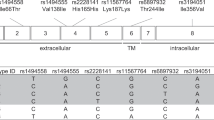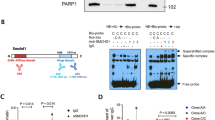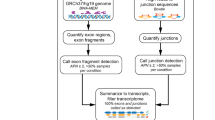Abstract
Genetic variation at a linkage disequilibrium block encompassing the cytotoxic T-lymphocyte antigen-4 (CTLA4) gene influences susceptibility to autoimmunity, but identifying the polymorphism(s) responsible for this effect has been challenging. Recently, a single-nucleotide polymorphism (SNP) located 3′ to the known polyadenylation site of CTLA4 (+6230G>A) and strongly associated with autoimmune disease was reported to regulate levels of soluble CTLA4 isoform (sCTLA4) but not the full-length isoform. The purpose of the present study is to define the mechanistic effect of the 3′SNP on the isoforms of CTLA4 (alternative splicing vs polyadenylation vs effects on RNA stability). However, using allele-specific single-nucleotide primer extension, we found no difference between mRNA transcripts derived from either +6230G>A allele in 11 heterozygous individuals, in either of the two known CTLA4 isoforms. We also found no effect of this polymorphism on ICOS (inducible costimulator), a putative downstream target. In addition, repeated attempts at 3′ RACE (3′rapid amplification of cDNA ends) were unsuccessful in amplifying any contiguous sequence past the known CTLA4 polyadenylation site and no such sequence was found in the EST databases. We conclude that the mechanism of the observed association of the +6230 SNP with autoimmune disease remains to be determined, but does not involve modulation of steady-state mRNA of any known CTLA4 isoform.
This is a preview of subscription content, access via your institution
Access options
Subscribe to this journal
Receive 6 digital issues and online access to articles
$119.00 per year
only $19.83 per issue
Buy this article
- Purchase on Springer Link
- Instant access to full article PDF
Prices may be subject to local taxes which are calculated during checkout




Similar content being viewed by others
References
Marron MP, Raffel LJ, Garchon HJ et al. Insulin-dependent diabetes mellitus (IDDM) is associated with CTLA4 polymorphisms in multiple ethnic groups. Hum Mol Genet 1997; 6: 1275–1282.
Nistico L, Buzzetti R, Pritchard LE et al. The CTLA-4 gene region of chromosome 2q33 is linked to, and associated with, type 1 diabetes. Belgian Diabetes Registry. Hum Mol Genet 1996; 5: 1075–1080.
Van der Auwera BJ, Vandewalle CL, Schuit FC et al. CTLA-4 gene polymorphism confers susceptibility to insulin-dependent diabetes mellitus (IDDM) independently from age and from other genetic or immune disease markers. The Belgian Diabetes Registry. Clin Exp Immunol 1997; 110: 98–103.
Marron MP, Zeidler A, Raffel LJ et al. Genetic and physical mapping of a type 1 diabetes susceptibility gene (IDDM12) to a 100-kb phagemid artificial chromosome clone containing D2S72-CTLA4-D2S105 on chromosome 2q33. Diabetes 2000; 49: 492–499.
Ueda H, Howson JM, Esposito L et al. Association of the T-cell regulatory gene CTLA4 with susceptibility to autoimmune disease. Nature 2003; 423: 506–511.
Vaidya B, Pearce S . The emerging role of the CTLA-4 gene in autoimmune endocrinopathies. Eur J Endocrinol 2004; 150: 619–626.
Staal FJ, Clevers HC . Wnt signaling in the thymus. Curr Opin Immunol 2003; 15: 204–208.
Wang XB, Zhao X, Giscombe R, Lefvert AK . A CTLA-4 gene polymorphism at position −318 in the promoter region affects the expression of protein. Genes Immun 2002; 3: 233–234.
Anjos SM, Tessier MC, Polychronakos C . Association of the CTLA4 gene with Type 1 Diabetes: evidence for independent effects of two polymorphisms on the same haplotype block. J Clin Endocrinol Metabo 2004; 89: 6257–6265.
Anjos S, Polychronakos C . Mechanisms of genetic susceptibility to type I diabetes: beyond HLA. Mol Genet Metab 2004; 81: 187–195.
Kouki T, Sawai Y, Gardine CA et al. CTLA-4 gene polymorphism at position 49 in exon 1 reduces the inhibitory function of CTLA-4 and contributes to the pathogenesis of Graves' disease. J Immunol 2000; 165: 6606–6611.
Anjos S, Nguyen A, Ounissi-Benkalha H, Tessier MC, Polychronakos C . A common autoimmunity predisposing signal peptide variant of the cytotoxic T-lymphocyte antigen 4 results in inefficient glycosylation of the susceptibility allele. J Biol Chem 2002; 277: 46478–46486.
Buckland PR . Allele-specific gene expression differences in humans. Hum Mol Genet 2004; 13 (Special No. 2): R255–R260.
Pastinen T, Hudson TJ . Cis-acting regulatory variation in the human genome. Science 2004; 306: 647–650.
Kaijzel EL, Bayley JP, van Krugten MV et al. Allele-specific quantification of tumor necrosis factor alpha (TNF) transcription and the role of promoter polymorphisms in rheumatoid arthritis patients and healthy individuals. Genes Immun 2001; 2: 135–144.
Wilson AG, Symons JA, McDowell TL, McDevitt HO, Duff GW . Effects of a polymorphism in the human tumor necrosis factor alpha promoter on transcriptional activation. Proc Natl Acad Sci USA 1997; 94: 3195–3199.
Hudson TJ . Wanted: regulatory SNPs. Nat Genet 2003; 33: 439–440.
Anjos SM, Tessier MC, Polychronakos C . Association of the cytotoxic T lymphocyte-associated antigen 4 gene with type 1 diabetes: evidence for independent effects of two polymorphisms on the same haplotype block. J Clin Endocrinol Metab 2004; 89: 6257–6265.
Giannoukakis N, Deal C, Paquette J, Goodyer CG, Polychronakos C . Parental genomic imprinting of the human IGF2 gene. Nat Genet 1993; 4: 98–101.
Reik W, Walter J . Genomic imprinting: parental influence on the genome. Nat Rev Genet 2001; 2: 21–32.
Morley M, Molony CM, Weber TM et al. Genetic analysis of genome-wide variation in human gene expression. Nature 2004; 430: 743–747.
McCann JA, Zheng H, Islam A, Goodyer CG, Polychronakos C . Evidence against GRB10 as the gene responsible for Silver-Russell syndrome. Biochem Biophys Res Commun 2001; 286: 943–948.
Bray NJ, Buckland PR, Owen MJ, O'Donovan MC . Cis-acting variation in the expression of a high proportion of genes in human brain. Hum Genet 2003; 113: 149–153.
Acknowledgements
We would like to thank Dr Cindy Goodyear for collection of the thymus samples and Marylène Rousseau for her technical expertise and help in the SNuPe assay.
Author information
Authors and Affiliations
Corresponding author
Additional information
Suzana Anjos is supported by a doctoral studentship awarded to her by the Canadian Institute of Health Research in partnership with the Thyroid Foundation. This work was supported by a research grant awarded by the Juvenile Diabetes Research Foundation (JDRF).
Rights and permissions
About this article
Cite this article
Anjos, S., Shao, W., Marchand, L. et al. Allelic effects on gene regulation at the autoimmunity-predisposing CTLA4 locus: a re-evaluation of the 3′ +6230G>A polymorphism. Genes Immun 6, 305–311 (2005). https://doi.org/10.1038/sj.gene.6364211
Received:
Revised:
Accepted:
Published:
Issue Date:
DOI: https://doi.org/10.1038/sj.gene.6364211
Keywords
This article is cited by
-
CTLA-4 +49A/G gene polymorphism and type 1 diabetes mellitus in the Chinese population: a meta-analysis of 2238 subjects
International Journal of Diabetes in Developing Countries (2016)
-
Association between cytotoxic T lymphocyte antigen-4 +49A/G, −1722T/C, and −1661A/G polymorphisms and cancer risk: a meta-analysis
Tumor Biology (2014)
-
CT60 single-nucleotide polymorphism as a surrogate marker for donor lymphocyte infusion outcome after allogeneic cell transplantation for acute leukemia
Bone Marrow Transplantation (2012)
-
Association of CTLA-4 gene polymorphisms with sporadic breast cancer risk and clinical features in Han women of Northeast China
Molecular and Cellular Biochemistry (2012)
-
Two-stage genome-wide association study identifies integrin beta 5 as having potential role in bull fertility
BMC Genomics (2009)



